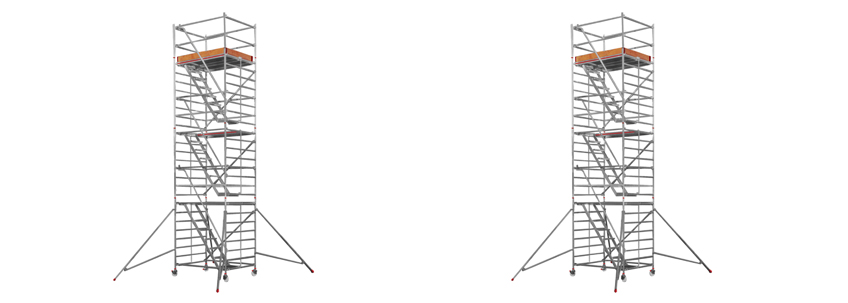
Scaffolding towers are indispensable tools in modern construction, providing safe and efficient access to elevated work areas. From painting tall buildings to undertaking large-scale infrastructure projects, these towers ensure worker safety, enhance productivity, and support a variety of tasks. Let's dive into the different types of scaffolding towers, their unique advantages, and how they cater to various construction needs.
What Are Scaffolding Towers?
Scaffolding towers are modular, temporary structures designed to provide stable working platforms at height. Unlike traditional scaffolding, they are easier to assemble, dismantle, and often come equipped with advanced features like wheels for mobility or adjustable heights for added versatility. These towers are extensively used across industries for painting, repairs, construction, and maintenance tasks.
Types of Scaffolding Towers
1. Fixed Scaffolding Towers
Fixed scaffolding towers are stationary structures built for stability and long-term projects.
Movable or mobile scaffolding towers are mounted on lockable wheels, allowing for easy repositioning.
These towers are designed with integrated stairs, making them safer and more efficient for ascending and descending.
Fixed scaffolding towers are stationary structures built for stability and long-term projects.
- Aluminium Pipes: Higher upfront cost but lower transportation and labor expenses due to their lightweight nature.
- Steel Pipes: Economical in initial purchase but can incur higher costs for transportation and corrosion protection.
Movable or mobile scaffolding towers are mounted on lockable wheels, allowing for easy repositioning.
- Applications: Ideal for tasks requiring access across multiple locations, such as warehouse maintenance or painting projects.
- Features: Lightweight frames with lockable castors for enhanced mobility and stability.
These towers are designed with integrated stairs, making them safer and more efficient for ascending and descending.
- Applications: Perfect for high-rise building construction or any project where workers frequently need to move between levels.
- Features: Equipped with handrails, non-slip treads, and wide steps for safety and convenience.
Advantages of Scaffolding Towers
1. Enhanced Worker Safety
Safety is a top priority, and scaffolding towers are built with features like guardrails, non-slip surfaces, and stabilizers to minimize risks.
2. Time and Labor Efficiency
Quick assembly and dismantling reduce labor hours, while modular designs ensure easy customization for diverse tasks.
3. Versatility
Scaffolding towers are adaptable to various projects, from painting facades to complex infrastructure repairs.
4. Cost-Effectiveness
With options to rent or purchase, scaffolding towers offer flexible solutions that save money, especially for short-term projects. Explore rental options on this page.
Safety is a top priority, and scaffolding towers are built with features like guardrails, non-slip surfaces, and stabilizers to minimize risks.
2. Time and Labor Efficiency
Quick assembly and dismantling reduce labor hours, while modular designs ensure easy customization for diverse tasks.
3. Versatility
Scaffolding towers are adaptable to various projects, from painting facades to complex infrastructure repairs.
4. Cost-Effectiveness
With options to rent or purchase, scaffolding towers offer flexible solutions that save money, especially for short-term projects. Explore rental options on this page.
Key Features of Scaffolding Towers
| Feature | Description |
| Material | Aluminum or steel |
| Height Adjustability | Customizable to project needs |
| Mobility | Lockable wheels for easy movement |
| Safety Measures | Guardrails, toeboards, and stabilizers |
When to Use Different Types of Scaffolding Towers
1. Fixed Towers for Stability
When stability and long-term use are priorities, fixed scaffolding towers provide the most reliable solution.
2. Movable Towers for Dynamic Sites
For projects requiring frequent repositioning, such as interior painting or light installations, movable towers ensure efficiency.
3. Staircase Towers for Multi-Level Access
These towers are the ideal choice for large-scale projects where workers need seamless access to various levels. Learn more about advanced tower systems here.
When stability and long-term use are priorities, fixed scaffolding towers provide the most reliable solution.
2. Movable Towers for Dynamic Sites
For projects requiring frequent repositioning, such as interior painting or light installations, movable towers ensure efficiency.
3. Staircase Towers for Multi-Level Access
These towers are the ideal choice for large-scale projects where workers need seamless access to various levels. Learn more about advanced tower systems here.
How to Choose the Right Scaffolding Tower
- Assess Project Requirements: Understand the height, load capacity, and mobility needs of your project.
- Check Safety Standards: Ensure compliance with local safety regulations and industry guidelines.
- Evaluate Material Options: Opt for aluminum for lightweight needs or steel for heavy-duty applications.
- Consult Experts: For tailored solutions, connect with specialists in scaffolding systems. Contact us here for personalized recommendations.
Safety Guidelines for Scaffolding Towers
- Daily Inspections: Check for wear, damage, and structural stability before use.
- Use PPE: Ensure workers are equipped with helmets, harnesses, and non-slip footwear.
- Follow Load Limits: Never exceed the tower’s specified weight capacity.
Call to Action
Maximize safety and efficiency in your construction projects with high-quality scaffolding towers. Explore our range of scaffolding solutions or contact us today for expert guidance.
Recent Posts
